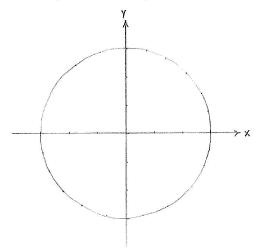Solution 4.1:6a
From Förberedande kurs i matematik 1
(Difference between revisions)
m (Lösning 4.1:6a moved to Solution 4.1:6a: Robot: moved page) |
|||
| Line 1: | Line 1: | ||
| + | If we write the equation as | ||
| + | |||
| + | |||
| + | <math>\left( x-0 \right)^{2}+\left( y-0 \right)^{2}=9</math> | ||
| + | |||
| + | |||
| + | we can interpret the left-hand side as the square of the distance between the points | ||
| + | <math>\left( x \right.,\left. y \right)</math> | ||
| + | and | ||
| + | <math>\left( 0 \right.,\left. 0 \right)</math>. | ||
| + | The whole equation says that the distance from a point ( | ||
| + | <math>\left( x \right.,\left. y \right)</math> | ||
| + | to the origin should be constant and equal to | ||
| + | <math>\sqrt{9}=3</math>, which describes a circle with its centre at the origin and radius | ||
| + | <math>\text{3}</math>. | ||
| + | |||
| + | |||
| + | |||
{{NAVCONTENT_START}} | {{NAVCONTENT_START}} | ||
<center> [[Image:4_1_6_a.gif]] </center> | <center> [[Image:4_1_6_a.gif]] </center> | ||
| - | + | ||
{{NAVCONTENT_STOP}} | {{NAVCONTENT_STOP}} | ||
Revision as of 11:27, 27 September 2008
If we write the equation as
\displaystyle \left( x-0 \right)^{2}+\left( y-0 \right)^{2}=9
we can interpret the left-hand side as the square of the distance between the points
\displaystyle \left( x \right.,\left. y \right)
and
\displaystyle \left( 0 \right.,\left. 0 \right).
The whole equation says that the distance from a point (
\displaystyle \left( x \right.,\left. y \right)
to the origin should be constant and equal to
\displaystyle \sqrt{9}=3, which describes a circle with its centre at the origin and radius
\displaystyle \text{3}.

